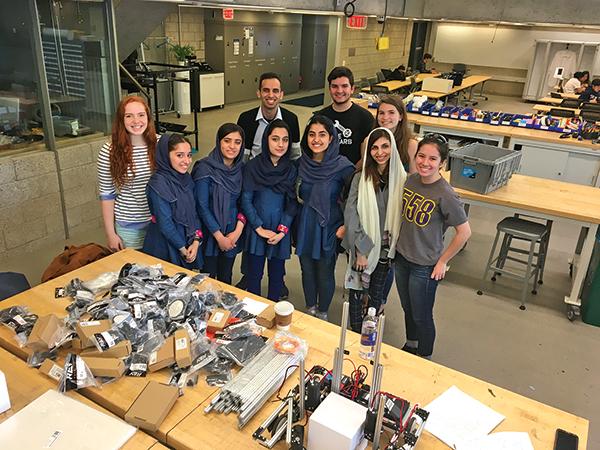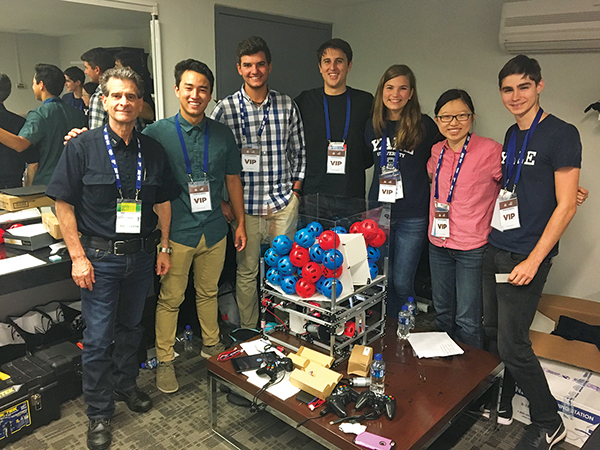A Global Effort

This story originally appeared in Yale Engineering magazine.
There are plenty of challenges involved with designing and building robots — even more so when you’re working from several different points on Earth.
This past summer, 17 Yale students worked with teams of high school students from eight countries for the 2018 FIRST Global Challenge, an annual international robotics competition held for four days in August in Mexico City. FIRST Global, a non-profit organization that focuses on STEM-related initiatives, held its first international competition last year in Washington D.C.
 As part of the organization’s Higher Education Network — designed to increase access to STEM education — Yale was among several universities with students serving as mentors to teams around the world. Two to three Yale mentors worked with each of the teams, from Bangladesh, Georgia, Japan, Afghanistan, Madagascar, Syria, Germany, and Liberia.
As part of the organization’s Higher Education Network — designed to increase access to STEM education — Yale was among several universities with students serving as mentors to teams around the world. Two to three Yale mentors worked with each of the teams, from Bangladesh, Georgia, Japan, Afghanistan, Madagascar, Syria, Germany, and Liberia.
In the weeks leading up to the competition, the teams and Yale students strategized and conferred on robot designs remotely, connecting via Skype, WhatsApp, and other technologies. At the Center for Engineering Innovation & Design (CEID), the Yale students worked on the same robot kits supplied to the teams in their home countries.
Robert Graf, coach for Germany’s team, said he and the students were grateful for the assistance from the team’s mentors, Evelyn Huang ’20 and Sebastian Rivero ’19.
“During the prototyping and building, we kept the two of them updated on our progress,” he said. “They were most supportive and encouraging, commenting on our designs and going the extra mile of keeping tabs on our social media accounts.”
And while the German team is a long-time veteran of the robotics competition, he said it was good to get some fresh insights from Huang and Rivero. At the same time, he said they ensured that the new ideas were also feasible.
“From time to time, we do get very crazy ideas like building a rope line and a gondola to deliver the cubes into the goal,” he said. “Fortunately, everyone talked us out of it. Our mentors nudged us to think unconventionally, but on the other hand, they also tethered us to reality when our creativity got ahead of us.”
Huang, though, was reluctant to take too much credit, adding that the German students were self-starters. “We helped them in the very beginning with design stuff, but honestly, most of it was them,” she said.
Razeen Ali, student team member for Bangladesh, praised mentors Ian Denzer ’21 and Michelle Tong ’21 for their work with the team. Denzer’s work at the event itself also proved critical.
“He had provided very interesting solutions to our robot design, which made it more functional,” he said.
“If it wasn’t for his time and design ideas and helping us rebuild/redesign our robot moments before our matches, we wouldn’t have done as well as we did.”
 Yale students Rowan Palmer ’21, Laura Wayland ’21, and Emily Chu ’19 worked with one of the competition’s best-known teams, from Afghanistan, which made headlines the previous year when they were initially denied visas for the competition in the U.S. They met briefly with the Yale students at the beginning of the summer before corresponding with them remotely. Team leader Roya Mahboob said working with the mentors was an “absolutely great experience,” even with some technical complications leading up to the event, which meant some serious scrambling at the actual competition.
Yale students Rowan Palmer ’21, Laura Wayland ’21, and Emily Chu ’19 worked with one of the competition’s best-known teams, from Afghanistan, which made headlines the previous year when they were initially denied visas for the competition in the U.S. They met briefly with the Yale students at the beginning of the summer before corresponding with them remotely. Team leader Roya Mahboob said working with the mentors was an “absolutely great experience,” even with some technical complications leading up to the event, which meant some serious scrambling at the actual competition.
“The students were working very hard with Yale University’s students on building a new robot while the competition was going on,” Mahboob said. “But I loved their not-giving-up attitude, positive behavior and persistence in working on the project. And the students from Yale were there all the time to help and support our students, and we were very appreciative of their patience and hard work.”
As is often the case with ambitious projects, not everything went smoothly for all the teams. For one thing, there were time differences.
“I was working with Sebastian and he was on the East Coast and I was on the West Coast, so we had a three-hour time difference and Germany had a six-hour time difference,” Huang said. Luckily, the German team regularly posted on their blog about their work. “They would update their progress there, and even if we weren’t in direct communication with them all the time, we could just check out their blog and see what they were up to.”
Time zones also plagued communication between the Yale students and the Bangladesh team, as did faulty Wi-Fi connections. But eventually things worked out. Denzer noted that WhatsApp allowed for individual calls between mentors and team members, and that probably worked out better.
From August 15th to 18th, more than 1,000 high school students from 193 countries came to Mexico City’s Arena Ciudad de México to take part in the competition. Besides the teams and their coaches and mentors, the event also drew thousands of spectators. Those in attendance also included Mexico President Enrique Peña Nieto and inventor and entrepreneur Dean Kamen, who founded FIRST Global.
Graf, Germany’s coach, said the competition was where the Yale mentors’ work really paid off.
“They made sure to drop by often, ask about our scores, our robot and our games — and their positive attitude was really infectious,” he said. He did add, however, that “our snacks were diminishing suspiciously fast when they were around.”
 Besides the competition itself, many said the real thrill of the event was the chance for young people from nearly every country in the world to gather in one building and cheer each other on. The teams were arranged in alphabetical order, so there were kids from Uruguay hanging out with competitors from Uzbekistan, while not far away, the Azerbaijan team was comparing notes with the team from the Bahamas.
Besides the competition itself, many said the real thrill of the event was the chance for young people from nearly every country in the world to gather in one building and cheer each other on. The teams were arranged in alphabetical order, so there were kids from Uruguay hanging out with competitors from Uzbekistan, while not far away, the Azerbaijan team was comparing notes with the team from the Bahamas.
“Watching all the kids run around going crazy and saying hi to everyone else was probably the coolest part of the program,” Rivero said. “It’s impressive to have an event where there’s kids from almost every country on the planet all there. You’ll see kids from five different countries who have probably never interacted otherwise, and they’re all having a conversation about, you know, a robot.”
The nature of the competition also fostered teamwork and cooperation. Each year, the competition focuses on one of the 14 Grand Challenges of Engineering identified by the National Academy of Engineering. This year’s theme was the impact of energy. The teams were split into three-nation partnerships, which would compete against other alliances to see whose robots could pick up and carry the most power cubes and solar panels to the goals on the field. While some robots might be good at picking up cubes, other robots were better at picking up solar panels. That meant that the teams had to learn quickly how to work together and strategize.
Ali of the Bangladesh team said that being part of a group that was representing his country was an “irreplaceable feeling.” And seeing the robot they had been working on for months finally on the field and competing against others was remarkable.
“We knew that our two months’ worth of hard effort and the large amount of time we spent preparing for this event had finally paid off,” he said. “We didn’t let our losses in the first few matches bother us. Instead, it motivated us to make last moment changes and finally make it work.”
He added that the international spirit of the event may have been the most exciting part of the trip.
“It was really astounding to see people from all around the world in one venue,” he said. “It gave us a great opportunity to make international friends and meet people we’ll never forget due to the memories we made together. This is something we would definitely do again and again.”

